The idea of farm-to-table foods has taken off in the last couple of years, with people wanting that fresh, crisp organic taste that only locally-grown foods provide. One way to get this same fantastic deliciousness right to your door is by planting your own group of easy to grow fruit trees.
While this option may seem like an overwhelming task at first, plenty of candidates require limited effort to develop. Keeping these trees alive and thriving is a piece of cake if you’ve ever tended to shrubs and flowers in your garden.
Surprisingly, some of your favorite fruits are relatively low-maintenance and easy to plant. If having enough space is a concern, there are also plenty of fruit trees that offer dwarf varieties for smaller areas. All that’s left to consider is your favorite fruit to eat and whether you live in a climate that adequately sustains it. The list below provides all the information you need to get started.

- Delicious Fruit Trees for Produce Plucked Straight from Home
- Goji Berry (Lycium barbarum)
- Pear Trees (Pyrus): Bears Delectable Fruit Quickly
- Plum Trees (Prunus domestica)
- Raspberries (Rubus idaeus)
- Fig Trees (Ficus carica): Easy to Grow Fruit Trees for Beginners
- Apricot Trees (Prunus armeniaca)
- Cherry Trees (Prunus avium): Full of Vitamins
- Blueberries (Cyanococcus)
- Apple Trees (Malus domestica)
- Blackberries (Rubus fruticosus) – Delicious Perennial Berries
- Peach Trees (Prunus persica)
- Lemon Trees (Citrus × limon): Tangy Fruits with Long Harvests
- Kumquat (Citrus japonica)
- Honeyberries (Lonicera caerulea)
Delicious Fruit Trees for Produce Plucked Straight from Home
Beyond taste, all fruit is packed with nutrients and vitamins our bodies crave. To help make your choice even easier, we added a few tidbits about how each fruit contributes to a healthy lifestyle.
It’s also easy to grow different pineapple varieties by rooting the crown of an existing pineapple. It does take a long time to grow, though, so be prepared to wait a while for harvesting. The same holds true when you grow avocados from seed.
Goji Berry (Lycium barbarum)

An uncommon though still incredibly delicious fruit tree to plant is the Goji Berry. These yummy little fruits provide healthy antioxidants that boost the immune system and lessen the effects of inflammation.
The tree develops fruit within the first two years, with full fruiting taking place between 3-5 years after planting. These deciduous trees are often a little thorny and reach heights of up to 12 feet tall.
Generally, they stay around 3-6 feet in height when well-groomed. Goji berries do not tolerate saline soils but prefer those with plenty of nutrients and a neutral to alkaline pH level. They require at least 8 hours of sunlight to thrive and well-drained soil.
Pear Trees (Pyrus): Bears Delectable Fruit Quickly
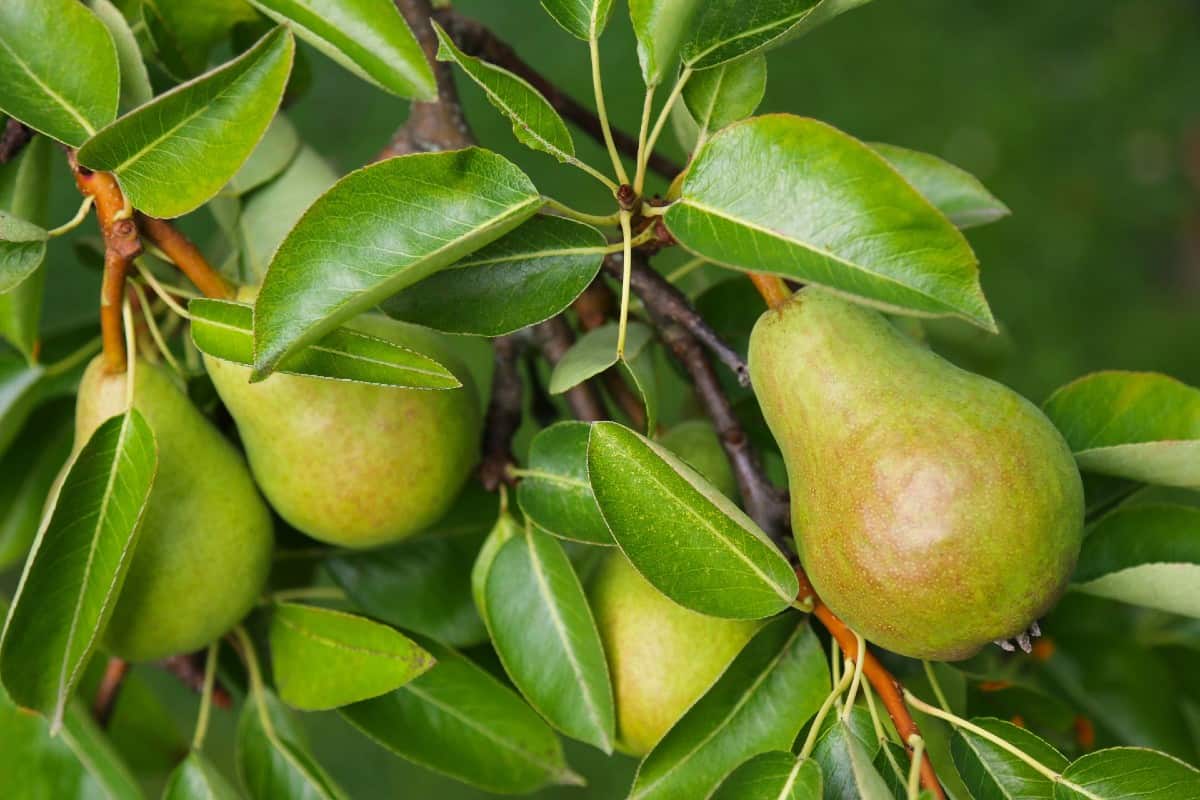
Pears need no introduction when it comes to household favorites. They are fat and cholesterol-free, making them excellent sources of dietary fiber for low-calorie meals.
Unlike plants that take several years to bear fruit, they yield yummy treats after only 1-2 short years. Standard pear trees grow to about 20 feet tall, while dwarf versions only grow to about 10 feet.
Planting them in late winter or early spring is ideal, as well as giving them plenty of sunlight to flourish. Pear trees do best in sandy loam soil with plenty of air circulation for the rootstock to breathe.
It also adjusts well to clay soil when supplementing missing nutrients with peat moss and compost along the earth’s surface. Planting them in raised beds is an excellent way to regulate the ground conditions.
Plum Trees (Prunus domestica)

Another nutritious source of vitamins and minerals is the plum. These fruits reduce the instance of common chronic diseases such as osteoporosis, heart disease, and diabetes.

The fruit grows after approximately 3-6 years, with a harvest season lasting from early summer to September. The canopy of plum trees spread to about 20 feet wide, while the tree itself may grow from 15-30 feet tall.
It produces lovely burgundy foliage in the fall and enjoys 6-8 hours of full sun. It adapts well to a wide array of soil types, as long as there is plenty of water and nutrients maintained within it, though it prefers soil that is moist and high in organic matter.
Raspberries (Rubus idaeus)

One of the best fruit options to plant is a shrub rather than a tree. Raspberries only grow between 3-5 feet tall and can easily be maintained in containers, making them perfect for households with limited space.
However, they grow incredibly fast, so it is essential to prune them regularly to keep them tame. The best time to trim raspberry bushes is after you pick the fruit. Raspberries thrive in soil with fantastic drainage and sandy loam soil.
Rich organic mulch also helps keeps them healthy while removing old branches that bore fruit paves the way for new growth the following year. These plants require 6-8 hours of direct sunlight. Plant them in autumn for the best results.
Fig Trees (Ficus carica): Easy to Grow Fruit Trees for Beginners

Many people associate figs with their ability to promote healthy digestion and lower cholesterol levels. Figs do this by allowing you to feel fuller longer and controlling your blood sugar levels.
Trees grow to around 20 feet tall and wide, with regular pruning necessary to properly maintain them. In approximately 3-5 years, they bear delicious fruit ready for consumption.
Fig trees are fantastic sources of shade, especially in warmer climates, in which they thrive. Specifically, they do best in USDA hardiness zone 8-10 and should be brought indoors when temperatures drop anywhere below 10 ℉.
Give them sandy or clay loam soil high in lime content and 8 hours of direct sunlight to survive.
Apricot Trees (Prunus armeniaca)

The apricot is another phenomenal fruit rich in beta carotene and vitamins that protect against typical illnesses like heart disease and diabetes.
Commonly seen in the western region of the country, they like warm springs and summers where they can bask in the sun for several hours a day.
Their velvety skin and hard pits easily identify them as stonefruit, members of the same family as plums, peaches, and cherries. Apricots typically grow between 15 and 20 feet tall when left unpruned.
Watering them weekly and keeping their soil drained adequately is essential to successful growth. Keeping their fruit spaced far enough apart is equally as important.
Thinning the amount of fruit in the beginning stages of growth allows the apricots plenty of room to spread and attain their full size.
Cherry Trees (Prunus avium): Full of Vitamins

Another member of the stonefruit family, cherries, actually come in two different taste brackets: sweet and sour cherries. The sweet variety makes tasty snacks all on their own, while the bitter kind typically makes their way into pies and other cooked meals.
Sour cherry trees yield noticeably smaller fruit and take less time to produce them, 3-5 years versus the 4-7 years for sweet cherries. No matter what the variety, cherries are fantastic sources of folic acid, potassium, and calcium.
They promote healthy cell growth and balance out blood pressure. Growing mainly in zones 5-9, they love moist soil and can even be propagated from their pits when placed in a small container.
They reach heights of around 12-15 feet, with dwarf trees only growing to 6 feet tall.
Blueberries (Cyanococcus)
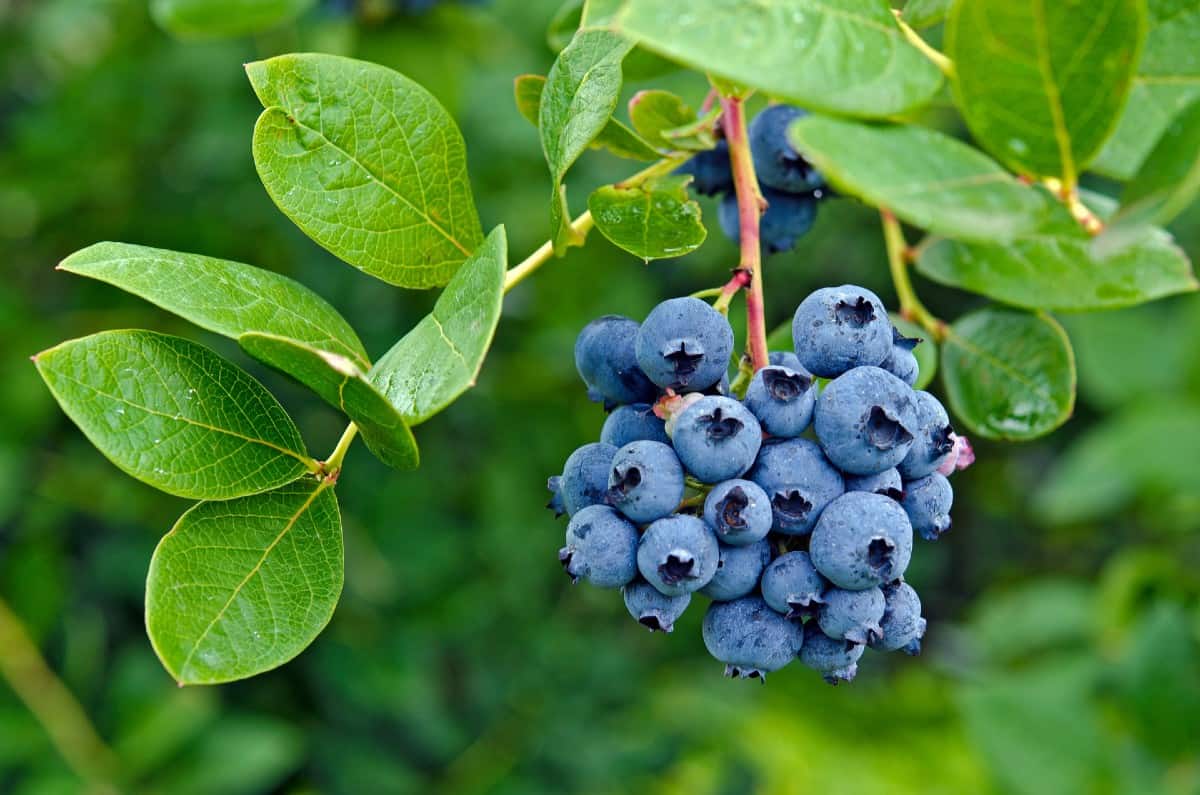
Blueberries provide delicious berries in the late summer, and they also display lovely white flowers in late spring. These fragrant blooms assist the plant with pollination by luring bees and butterflies to its branches.
There are some self-pollinating varieties of blueberries available, which need only one plant to continue producing fruit. The plant loves acidic soil and generally only grows to about 6 feet high.
Compact versions of the shrub are also available for container gardening in smaller areas. After three years, tiny berries form that contain antioxidants, along with anti-inflammatory properties and vitamins.
Apple Trees (Malus domestica)

Apple trees are one of the most commonly planted fruit trees out there. And who wouldn’t? They’re extremely low-maintenance and provide delicious, healthy fruit.
In addition to increasing fiber intake, apples lower the risk of lung disease and decrease the chances of getting colon and breast cancer.
These trees reach heights of up to 40 feet tall, though most gardeners prune them back to only about 20 feet. Dwarf apple varieties stay at around 8 feet tall, making it much more manageable for first-time fruit growers.
Growing fruit trees like apples requires that they have at least 6-8 hours of direct sunlight, especially during the growing season. The plant bears fruit starting in late summer, generally after 2-10 years from planting. Smaller species lean toward the shorter time frame.
We can also show you when to spray neem oil on apple trees to repel pests that harm the tree or worms that burrow into the fruit. Protecting your fruit trees from pests is essential to keep apple trees growing fast.
Knowing when are apples ripe is important in the harvesting process, too.
Blackberries (Rubus fruticosus) – Delicious Perennial Berries
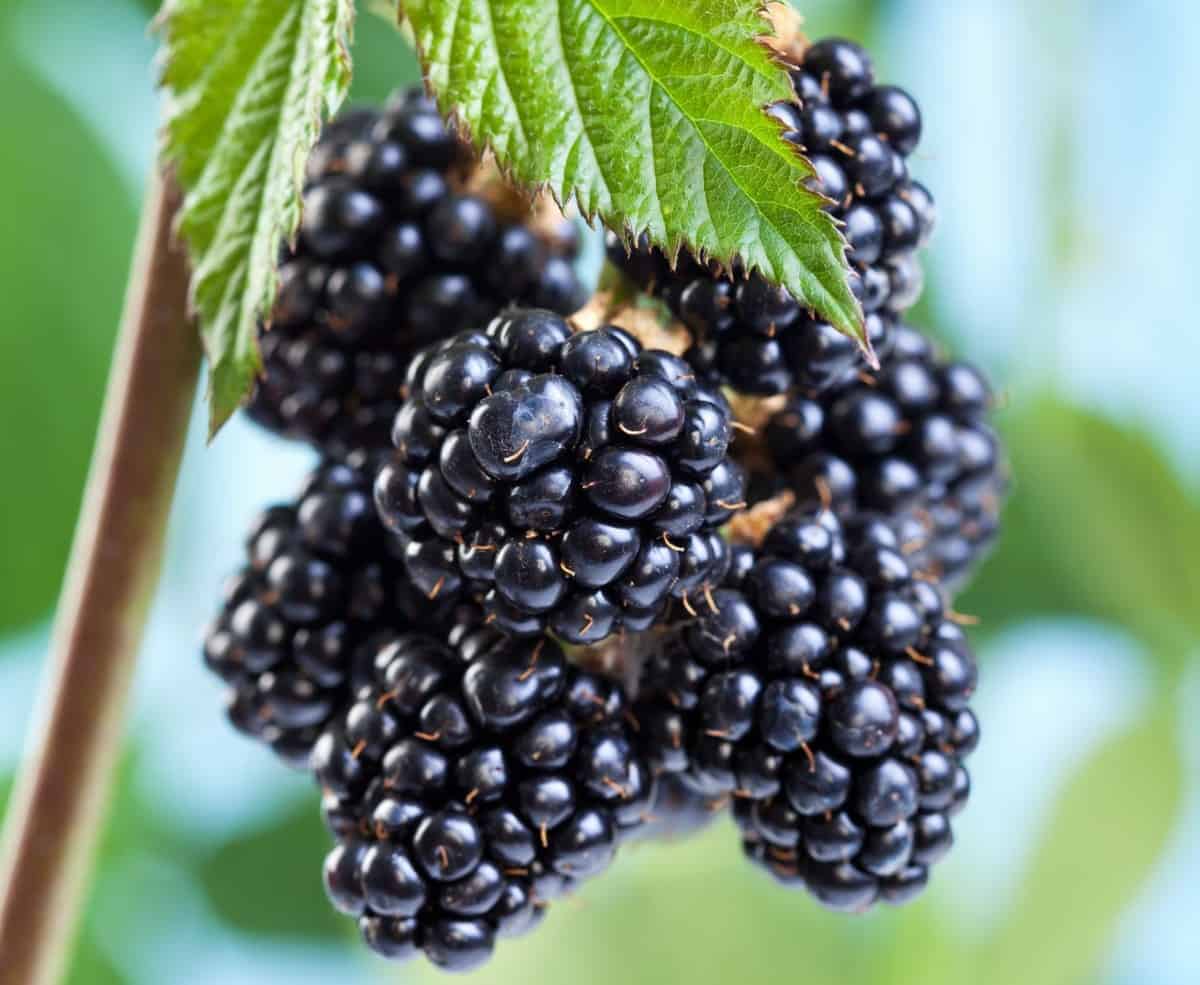
Blackberries are another source of potassium and calcium that also provide nutrients in the form of magnesium. They generate a high amount of anthocyanins, a type of antioxidant that protects against toxins and stressors and gives the plant its dark hue.
One difference between mulberry and blackberry plants is that mulberries grow on trees, which the blackberry perennial remains small and compact, only standing about 3-4 feet tall and wide with prickly thorns. The fruiting season takes place during the summer until the early fall. Do not pick the fruit immediately after it reaches its dark black hue, however.
Instead, waiting for 3-4 days afterward, when they start to fade slightly, ensures the most delicious harvest.
The way to grow blackberries is to keep blackberry plants in full sun, with only light shade whenever necessary. Soil should be slightly acidic, well-drained, and with at least 2 inches of compost at the top.
What about mulberries? How long do mulberries take to grow? If you grow from a sapling, you should have tasty fruit within two to three years.
Peach Trees (Prunus persica)

Also known as nectarines, peaches are well-known for helping the consumer develop resistance to infections through numerous vitamins and minerals.
While standard trees grow to 25 feet tall, grooming them back keeps them at a much more manageable height of 12 feet. Dwarf trees grow even smaller, reaching only about 6 feet high.
How well the plant bears fruit revolves around the amount of sunlight it gets throughout the growing season. Having at least 6-8 hours of full sun makes this possible, while also preventing potential fungus problems.
Proper drainage is also vital to maintaining healthy and quality fruit, as poorly-circulated, wet soil damages the root system quickly. Peaches are self-fertile, with harvests taking place throughout the summer after 2-4 years of planting.
Before harvesting, learn the right way to tell if peaches are good and ripe and ready for plucking to eat right off the branch or to add to a cobbler.
Lemon Trees (Citrus × limon): Tangy Fruits with Long Harvests

Another citrus candidate perfect for growing at home is the lemon. These fruits assist with everything from weight loss to kidney stones and other digestive concerns.
Their biggest enemy is frost, which is easily remedied by growing them closer to the house to buffer them from the cold. Lemon trees typically grow up to 20 feet tall, though dwarf varieties grow no more than half that size.
Some are even perfect trees you can grow in pots on porches or near bright windows indoors. After three years, they bear fruit. The primary harvest season for lemons lasts from late winter on into early spring.
Some even bear fruit through early summer, while species like the “Eureka” lemons produce the tart specimen all year long.
Kumquat (Citrus japonica)
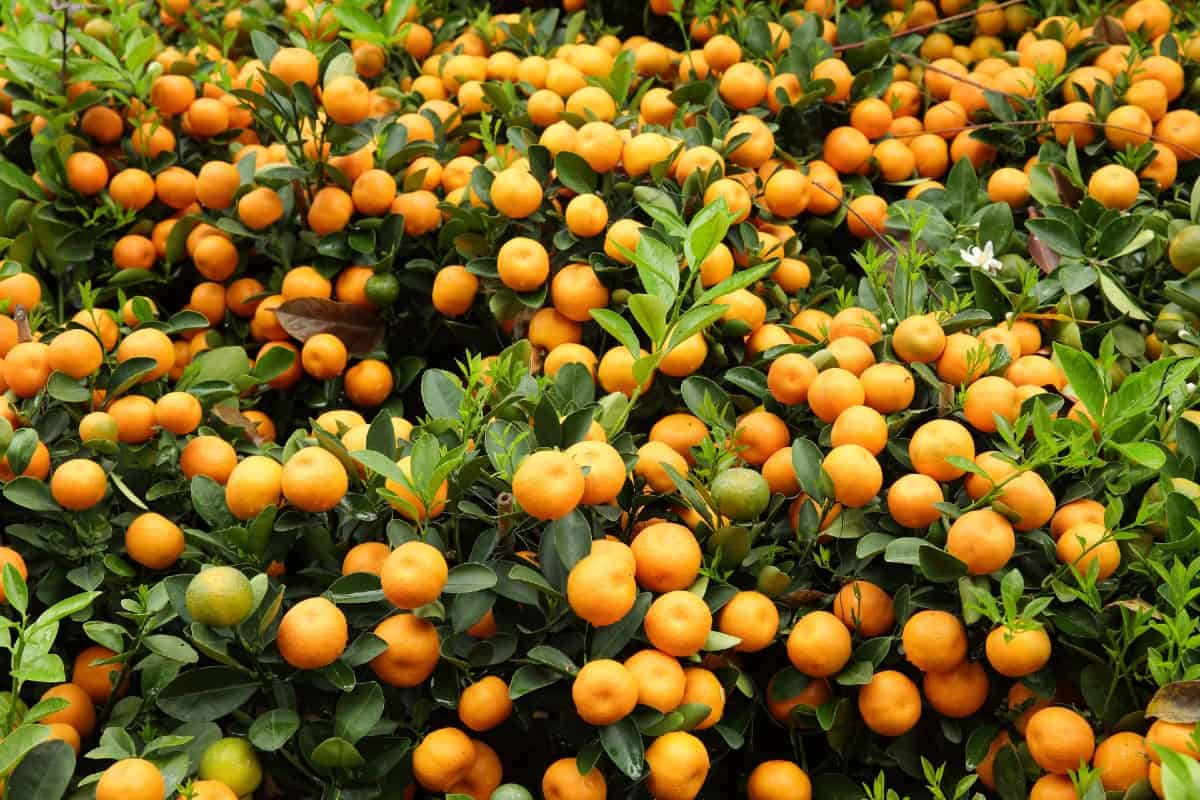
Kumquats are some of the most low-maintenance fruit trees to grow. They tolerate most soil types and pH levels and even withstand seaside conditions.
Most commonly found in tropical climates, these attractive citrus trees survive best in USDA zones 9-10, where temperatures rarely fall below their cold threshold of 18℉. These filling foods make excellent weight loss fruits since they are high in water content and low in calories.
They spread to about 6 feet wide and 8 feet tall and require at least 6 hours of full sun. Some varieties even do well indoors.
Although harvest times vary depending on the species and regions, it generally starts in November and potentially lasts through early spring.
Honeyberries (Lonicera caerulea)
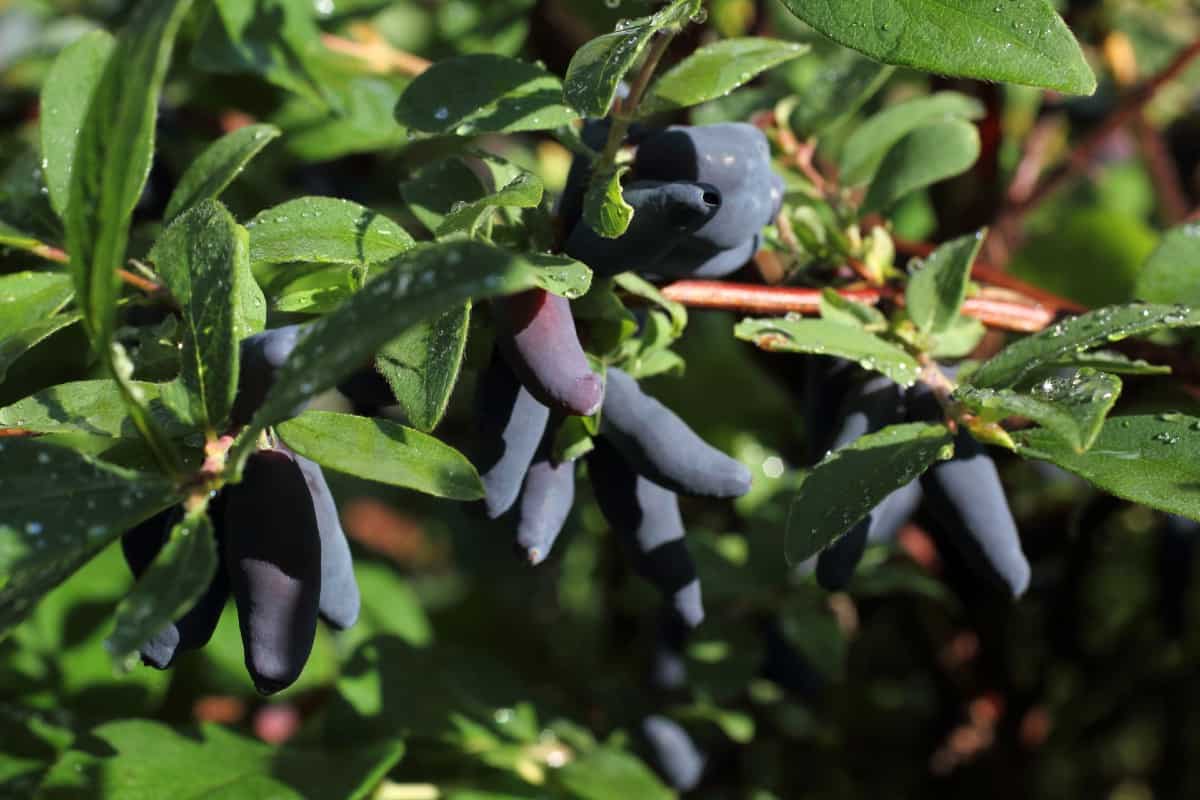
Honeyberries generate enough vitamins to outshine other fruits, all of which assist with eye health and prevent issues like colon cancer. A relative of honeysuckle, the fruit grows in late spring and remains until the beginning of summer.
These plants are small fruit trees that reach about 8 feet tall, with most staying closer to three feet. They do just as well in partial sun as they do in full sun and grow even in clay soil. Their most important requirement for healthy development is adding humus-rich fertilizer.
Whether you are growing avocado trees in containers at home or one of these delicious fruits, you now know all the different possibilities available to you. Making your decision relies on nothing more than a palate preference.
Whether you prefer the tart and tangy flavors of citrus, or the sweet, delicious notes of stonefruit, there is a low-maintenance fruit tree suited to everyone’s tastes.

If you found these tree growing tips useful, please remember to share which easy to grow fruit trees are your favorite with family and friends on Facebook and Pinterest.